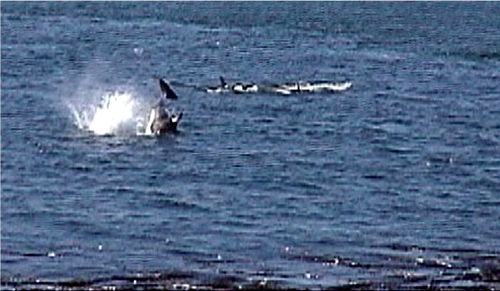|
San Juan Wildlife & Nature Photography Matt Ragen |
 |
|
|
|
||
| |||||||||
|
Orca Whale Photos
| |||||||||||||||||||||||||||||||||||
| Gallery - Orca Whales / Killer Whales | |||

A Family Of Killers |

Two Whales Surfacing |

A Breath Of Air |

Mother and Baby |
 Whale Breaching |
 A Lineup Of Killers |
 Orca Off The Rocks |
 A Pod Of Killers |
 Serenity at Sea |
Visit our page of archival photos | ||
Over the last ten years, we've watched the US and Canadian
whale watching fleet grow in size off the west coast of San Juan Island.
Unfortunately, the number of boats now often outnumbers the number of killer
whales that travel in front of our place. We think it's a shame that there are
this many boats, particularly since there is evidence that the
noise created from the engines on the whale watching boats is thought to threaten the whales' ability to
use their sonar to locate food. It's just one more threat to their existence in
addition to pollution and increasingly common food shortages from over-fishing of salmon in Puget
Sound.

The final photo was snapped in the summer of 2000.
The whale is 'lobtailing' -- that is, slapping its tail on the water.
Since all of our orca pictures were taken from shore, even though it does takes quite a bit of luck in terms of timing, it goes to show that you can get really good pictures without causing the potential harm to the whales by watching more closely from boats. Check out the reference to our pictures of killer whales at Orca Relief!
|
There are many great photography and natural history books and videos on Orca whales currently available from Amazon.com: |
|||||
|
|
||||
|
There are some great out-of-print books on killer whales that can often be found at used bookstores. These include:
| |||||
| To get other useful background information on killer whales as well as to see some great photography, check out some of our favorite wildlife web links. | |||||
![]()
Additional Background on the Orca Whales of the San Juan Islands
[Note that this text is part of an article from the Orca Relief
Citizens' Alliance website which is devoted to conservation efforts for
the San Juan resident pods.]
Orcinus orca (killer whales) are the top predator in the marine ecosystem. With a 50MM year evolutionary run (compared to perhaps 3MM max for humans, if you stretch it), and with a brain considerably larger than ours in total neuron count and gross weight, Orca are perhaps the most social animals on the planet. Pods appear to be matriarchal in structure, and calves born into a pod never - that is, until a few weeks ago - leave it. You are born into a pod, and 40-80 years later, you die in that same small group (often 30-60) of whales.
In most parts of the world, they travel non-stop in a transient lifestyle which includes eating almost everything else in the food chain, with marine mammals such as seals at the top of the list, and penguins not far behind. In one place - Puget Sound and the waters of the Inland Passage - Orca are known to be "resident," instead of transient (transient pods also come into these waters, but do not stay). That is, they spend at least half the year in a very confined space, eating what, until a few decades ago, seemed a limitless supply of salmon, and using the currents and islands to focus this hunt, just as native Americans did with fish traps, in their own time.
One of the results of this evolutionary experiment with brain size, predation and time, has been the development of what is likely the most advanced sonic equipment on Earth. Orca sonar is an exquisitely powerful tool, able to detect, for instance, the difference between two identical cast aluminum cylinders at 150 yards, if one of them has a small cavity in its center.
| ||||||||||||